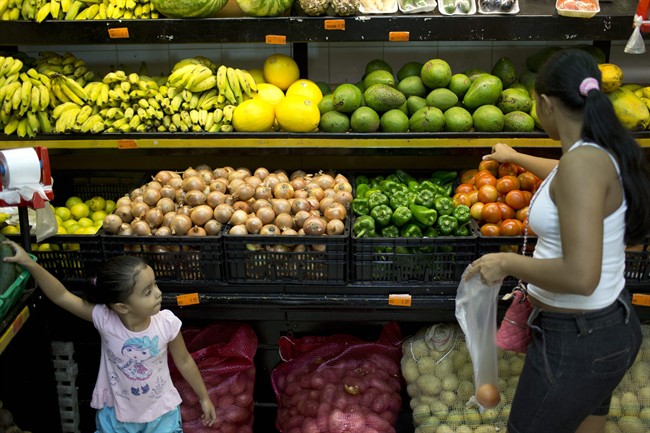A healthy diet is getting pricier in Canada.

Shoppers visiting Loblaw supermarkets in recent weeks have faced a stiff seven-per-cent jump in how much they’re paying for fruits, vegetables and produce in general.
Prices for fresh food jump in the winter as more produce is imported. But the current mini-spike in prices has little to do with the season. Rather, a crashing currency coupled with an easing of competitive pressures are responsible, experts say.
As the Canadian dollar remains worth significantly less than it has in recent winters, Loblaw — the country’s largest supermarket operator — has passed the resulting spike in its costs for imported food onto shoppers.
It’s a process Loblaw and the country’s other big grocers, like Sobeys, Safeway and Metro, have been gradually phasing in as the loonie’s erosion against the U.S. dollar has quickened.
The loonie was trading at just under 80 cents U.S. on Monday, down about 15 per cent compared to January of last year and 20 per cent compared to January 2013. The sharpest declines have taken place, however, since September in the midst of a collapse in oil prices.
The quickened decline in the loonie’s value has ratcheted up pressure on supermarket owners to either absorb the higher costs, or attempt to shift them onto shoppers. So far, they’ve managed to be able to do the latter without deterring shoppers and damaging sales.
Grocers “continue to have success at passing through higher wholesale costs of grocery to consumers,” experts at BMO Capital Markets said in Feb. 19 research note.
Loblaw will reveal its sales performance for the latest three-month stretch on Thursday this week, and experts suggest it will show a jump in sales at existing stores of at least 3 per cent, even as it has raised prices and cut back on promotions.
MORE: A new normal at the supermarket – fewer deals, higher prices
Pricing power
Unfortunately for shoppers, prices in the fresh food aisles and elsewhere in the store are expected to remain elevated, even once the domestic growing season kicks and more locally grown food grown winds its way into supermarkets.
Roughly 80 per cent of all produce taken home by grocery shoppers originates outside of Canada or is bought and sold at the wholesale level in U.S. dollars. Experts suggest the loonie could fall below 75 cents U.S. through 2015 before recovering next year.
- ‘Shock and disbelief’ after Manitoba school trustee’s Indigenous comments
- Canadian man dies during Texas Ironman event. His widow wants answers as to why
- Several baby products have been recalled by Health Canada. Here’s the list
- ‘Sciatica was gone’: hospital performs robot-assisted spinal surgery in Canadian first
“Wholesale food costs are expected to continue to inflate,” BMO analyst Peter Sklar said.
While lower pump prices are helping the consumer afford the bump in produce prices, food shoppers are also facing an environment where supermarkets have more power to pass through increases without as much concern that customers will head elsewhere.
The exit of Target Canada this spring means the rapid growth in recent years in the number of stores and retail square footage allotted to food sales is reversing course, applying less pressure on supermarket owners to keep prices lower.
MORE: In food fight, Canada’s discount grocers at Target’s lunch
Walmart aggression
The most significant competitive check on fast-rising grocery prices this year looks to be Walmart, which is aiming to continue its expansion into supermarket sales.
Walmart may again be embarking on a campaign of “price investments,” or reductions, in food categories at its growing number of Supercentre locations, experts say — though the price cuts may have been bigger had Target elected to remain in Canada, providing an alternative to Walmart or Canada’s big three supermarket operators.
MORE: Walmart winning a bigger chunk of Canadians’ grocery budgets
According to BMO’s monthly tracking of prices, the pace of food inflation at Walmart locations in key markets slowed last month.
“Walmart Supercentre’s retail grocery food inflation appears to have decelerated somewhat in both Ontario and Quebec from earlier,” Sklar said.
WATCH: The fluctuating Canadian dollar is a factor in how much you’re paying for your food. Sylvain Charlebois, a food industry expert and professor at the University of Guelph explains.




Comments